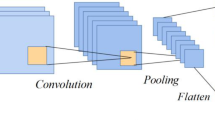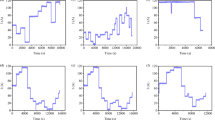Abstract
Since Lithium-ion (Li-ion) batteries are frequently used for real-time applications, evaluating their State of Health (SoH) is crucial to guarantee their effectiveness and safety. Model-based methods with SoH prediction are helpful. However, the issues with battery modelling have led to a greater dependence on machine learning (ML). As a significant step in assessing the effectiveness of ML techniques, data preprocessing has also drawn much attention. In this work, a new preprocessing method using relative State of Charge (SoC) is proposed; further, this paper describes a hybrid learning model (HLM) that combines auto-regressive integrated moving average (ARIMA), gated recurrent unit (GRU) and convolutional neural network (CNN). Data: proposed HLM uses time-series and SoC domain data; the ARIMA + GRU algorithm trains the time-series data, while CNN trains the SoC domain data. Both outputs are mean averaged to get the final output prediction. The proposed HLM is evaluated for root mean square error (RMSE), mean absolute error (MAE), and mean absolute percentage error (MAPE) using the National Aeronautics and Space Administration (NASA’s) randomized battery usage data set (RBUDS). The results indicate that the recommended HLM is more accurate and has a smaller error margin than existing ML models.











Similar content being viewed by others
Data Availability
Not applicable.
Code Availability
Not Applicable.
References
Global energy and CO2 emissions in 2020–global energy review 2020–analysis. IEA (2020). https://www.iea.org/reports/globalenergy-review-2020/global-energy-and-co2-emissions-in-2020.
Martin (2019) Climate change. In: United Nations sustainable development. https://www.un.org/sustainabledevelopment/climate-change/. Accessed 23 Jan 2021
Alattar AH, Selem SI, Metwally HM, Ibrahim A, Aboelsaud R, Tolba MA, El-Rifaie AM (2019) Performance enhancement of micro grid system with SMES storage system based on mine blast optimization algorithm. Energies 12(16):1–23
Martin, Energy. In: United Nations sustainable development. https://www.un.org/sustainabledevelopment/energy/
Lipu MSH, Mamun AA, Ansari S, Miah MS, Hasan K, Meraj ST, Abdolrasol MGM, Rahman T, Maruf MH, Sarker MR, Aljanad A, Tan NML (2022) Battery management, key technologies, methods, issues, and future trends of electric vehicles: a pathway toward achieving sustainable development goals. Batteries 8(9):119
Tran MK, Fowler M (2020) A review of lithium-ion battery fault diagnostic algorithms: current progress and future challenges. Algorithms 13(3):62
Texas Instruments. bq27220 Single-Cell CEDV Fuel Gauge (2016)
Dai H, Jiang B, Hu X, Lin X, Wei X, Pecht M (2021) Advanced battery management strategies for a sustainable energy future: multilayer design concepts and research trends. Renew Sustain Energy Rev 138:110480
Li Y, Sheng H, Cheng Y, Stroe DI, Teodorescu R (2020) State-of-health estimation of lithium-ion batteries based on semi-supervised transfer component analysis. Appl Energy 277:115504
Tian H, Qin P, Li K, Zhao Z (2020) A review of the state of health for lithium-ion batteries: research status and suggestions. J Clean Prod 261:120813
Sun C, Lin H, Cai H, Gao M, Zhu C, He Z (2021) Improved parameter identification and state-of-charge estimation for lithium-ion battery with fixed memory recursive least squares and sigma-point Kalman filter. Electrochim Acta 387:138501
Zhang L, Fan W, Wang Z, Li W, Sauer DU (2020) Battery heating for lithium-ion batteries based on multi-stage alternative currents. J Energy Storage 32:101885
Shu X, Shen S, Shen J, Zhang Y, Li G, Chen Z, Liu Y (2021) State of health prediction of lithium-ion batteries based on machine learning: advances and perspectives. iScience 24(11):103265
Tian H, Qin P, Li K, Zhao Z (2020) A review of the state of health for lithium-ion batteries: research status and suggestions. J Clean Prod 261:120813
Qian K, Huang B, Ran A, He Y-B, Li B, Kang F (2019) “State-of-health (SOH) evaluation on lithium-ion battery by simulating the voltage relaxation curves. Electrochim Acta 303:183–191
Chen Y, Kang Y, Zhao Y, Wang L, Liu J, Li Y, Liang Z, He X, Li X, Tavajohi N, Li B (2021) A review of lithium-ion battery safety concerns: The issues, strategies, and testing standards. J Energy Chem 59:83–99
Zhang L, Fan W, Wang Z, Li W, Sauer DU (2020) Battery heating for lithium-ion batteries based on multi-stage alternative currents. J Energy Storage 32:101885
Jiang B, Dai H, Wei X (2020) Incremental capacity analysis based adaptive capacity estimation for lithium-ion battery considering charging condition. Appl Energy 269:115074
Tian H, Qin P, Li K, Zhao Z (2020) A review of the state of health for lithium-ion batteries: research status and suggestions. J Clean Prod 261:120813
Andrenacci N, Vellucci F, Sglavo V (2021) The battery life estimation of a battery under different stress conditions. Batteries 7:88
Yang S, Zhou S, Hua Y et al (2021) A parameter adaptive method for state of charge estimation of lithium-ion batteries with an improved extended Kalman filter. Sci Rep 11:5805
Wang D, Yang F, Zhao Y, Tsui KL (2017) Battery remaining useful life prediction at different discharge rates. Microelectron Reliab 78:212–219
Ren L, Zhao L, Hong S, Zhao S, Wang H, Zhang L (2018) Remaining useful life prediction for lithium-ion battery: a deep learning approach. IEEE Access 6:50587–50598
Vazquez-Canteli JR, Nagy Z (2019) Reinforcement learning for demand response: A review of algorithms and modeling techniques. Appl Energy 235:1072–1089
Wei J, Dong G, Chen Z (2018) Remaining useful life prediction and state of health diagnosis for lithium-ion batteries using particle filter and support vector regression. IEEE Trans Industr Electron 65:5634–5643
Zhang Y, Xiong R, He H, Pecht M (2018) Long short-term memory recurrent neural network for remaining useful life prediction of lithium-ion batteries. IEEE Trans Veh Technol 67:5695–5705
Vatani M, Vie PJ, Ulleberg Ø (2018) Cycling lifetime prediction model for lithium-ion batteries based on artificial neural networks. In: Proceedings of IEEE PES innovative smart grid technologies conference Europe, Sarajevo, Bosnia and Herzegovina, Piscataway, NJ, pp 1–6
Mirzapour F, Lakzaei M, Varamini G, Teimourian M, Ghadimi N (2019) A new prediction model of battery and wind-solar output in hybrid power system. J Ambient Intell Hum Comput 10:77–87
Titos M, Bueno A, Garcia L, Benitez MC, Ibanez J (2019) Detection and classification of continuous volcano-seismic signals with recurrent neural network. IEEE Trans Geosci Remote Sens 57:1936–1948
LeCun Y, Bengio Y, Hinton G (2015) Deep learning. Nature 521:436–444
Bektas O, Jones JA, Sankararaman S, Roychoudhury I, Goebel K (2019) A neural network filtering approach for similarity-based remaining useful life estimation. Int J Adv Manuf Technol 101:87–103
Zhang Y, Xiong R, He H, Pecht MG (2018) Long short-term memory recurrent neural network for remaining useful life prediction of lithium-ion batteries. IEEE Trans Veh Technol 67(7):5695–705
Ling L, Wei Y (2021) State-of-charge and state-of-health estimation for lithium-ion batteries based on dual fractional-order extended kalman filter and online parameter identification. IEEE Access 9:47588–47602
Li J, Landers RG, Park J (2020) A comprehensive single-particle-degradation model for battery state-of-health prediction. J Power Sources 456:227950
Bonfitto A, Ezemobi E, Amati N, Feraco S, Tonoli A, Hegde S (2019) State of health estimation of lithium batteries for automotive applications with artificial neural networks. In: AEIT international conference of electrical and electronic technologies for automotive, Politecnico di Torino, Lingott, pp 21–25
Jo S, Jung S, Roh T (2021) Battery state-of-health estimation using machine learning and preprocessing with relative state-of-charge. Energies 14(21):7206
Yayan U, Arslan AT, Yucel H (2021) A novel method for SOH prediction of batteries based on stacked LSTM with quick charge data. Appl Art Intell 35(6):421–439
Bole B, Kulkarni C, Daigle M (2014) Randomized battery usage data set, NASA AMES prognostics data repository. In: Mountain view, CA
Kim IS (2009) A technique for estimating the state of health of lithium batteries through a dual-sliding-mode observer. IEEE Trans Power Electron 25:1013–1022
Ng KS, Moo CS, Chen YP, Hsieh YC (2009) Enhanced coulomb counting method for estimating state-of-charge and state-of health of lithium-ion batteries. Appl Energy 86:1506–1511
Zhang J, Lee J (2011) A review on prognostics and health monitoring of li-ion battery. J Power Sources 196:6007–6014
Kirchev A (2015) Electrochemical energy storage for renewable sources and grid balancing. Elsevier, Amsterdam, pp 411–435
Tomek I (1976) Two modifications of CNN. IEEE Trans Syst Man Commun 6:769–772
Funding
The researchers would like to acknowledge the Deanship of Scientific Research at Taif University for funding this work.
Author information
Authors and Affiliations
Contributions
VM: Writing-Review & Editing; SS: Investigation, Writing-Original Draft, Conceptualization, Methodology, Formal analysis; RA: Validation, Software, Data Curation; MA: Supervision, Funding.
Corresponding author
Ethics declarations
Conflict of interest
No Conflict of Interest.
Additional information
Publisher's Note
Springer Nature remains neutral with regard to jurisdictional claims in published maps and institutional affiliations.
Rights and permissions
Springer Nature or its licensor (e.g. a society or other partner) holds exclusive rights to this article under a publishing agreement with the author(s) or other rightsholder(s); author self-archiving of the accepted manuscript version of this article is solely governed by the terms of such publishing agreement and applicable law.
About this article
Cite this article
Myilsamy, V., Sengan, S., Alroobaea, R. et al. State-of-Health Prediction for Li-ion Batteries for Efficient Battery Management System Using Hybrid Machine Learning Model. J. Electr. Eng. Technol. 19, 585–600 (2024). https://doi.org/10.1007/s42835-023-01564-2
Received:
Revised:
Accepted:
Published:
Issue Date:
DOI: https://doi.org/10.1007/s42835-023-01564-2




